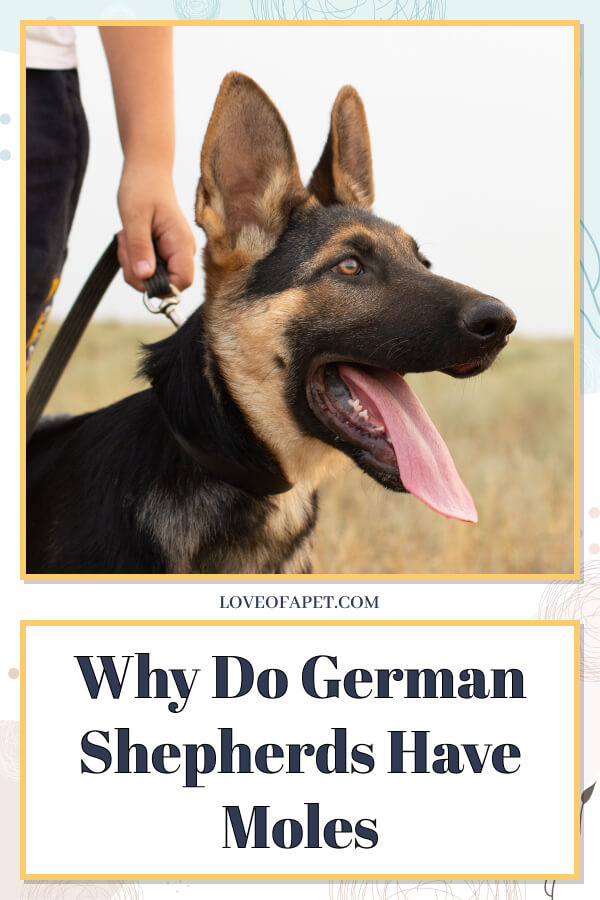German Shepherds are one of the most popular breeds of dogs in the world. They make excellent pets and companions for those who can give them a lot of attention as they need to be included as part of the family.
As we learned more about German Shepherds and started to think about purchasing one, we noticed some other interesting facts. One of the strangest things we found out was that many German Shepherds seem to have what appears to be a mole or beauty mark on their cheek.
Since you have noticed this mole on your dog, it is important for you to know more about what they are so that you can better understand your pup. Moles are usually black with a small round shape just below where the jaw meets the neck. To learn more about your dog, keep reading so we can discuss these moles in greater detail.
Contents
Why do german shepherds have moles?
Almost all dogs have a black circular patch in this region, but not all dogs. The black mole-like circle is also common for Belgian Malinois. So why do german shepherds have a black spot on their faces?
The black spot on a German Shepherd’s face that people often mistake for a mole or beauty mark is actually a round patch of hair called vibrissae. The vibrissae are a dog’s whiskers which transmit sensory messages to the brain.
Dogs have a set of stiff hairs that protrude from the sides of their muzzles and are called vibrissae. They can also be found on the lower jaw, above the eyebrows, and near the ears. They help the dog feel its way through the world and can also detect changes in air currents which helps them find prey.
Whiskers tend to be more rigid and embedded more deeply into the skin. Dogs can detect pressure on their whiskers and this is due to the high concentrations of touch-sensitive neurons at the base of each hair.
Vibrissae is an early warning system which helps the dog avoid crashing into objects; they help detect when something is approaching. When you tap on the hair on their face, the dog will blink in that eye and often turn its head away.
The animal’s tactile hairs are a huge part of their sensory functioning. They help with food acquisition, communication with different species, and aggression, among other things. Dogs’ vibrissae serve to help them perceive their surroundings and other things in their environment.
Despite the advantages of having whiskers, many pet owners choose to pluck them out. This leads to confusion and decreased spatial awareness in dogs.
The only time you will normally mess around with vibrissae (whiskers) is if your pet is entered in a dog show. There are four options for this: surgical removal, trimming, plucking, or just leaving the whiskers alone.
Can German Shepherds Get Moles?
In the same way that humans develop moles, it is also possible for the german shepherd dog or other breeds to have moles. However, in dogs, they are less common. Similarly, just like in humans, a mole can sometimes be a sign of a serious problem, and it is best to have a vet examine your furry companion if you suspect anything.
Moles are small, harmless dark spots that can appear on your dog’s skin. They are usually brown or black in color, and there is no inflammation around the site of the spot. You will often tell if it is a mole because they do not cause any symptoms such as pain or itching. It is important to note that if you soon notice irregularities in texture, shape, or coloration, then you should visit your vet.
Moles are small, brown, black, or blue bumps usually found on the body. The main cause of their appearance is a pigment in the body known as melanin. Melanin is what gives you tan after being in the sun. The growths with melanin are called melanocytic tumors. These are more common in animals with heavier pigmentation.
The vet will carry out a physical examination to see if there are other signs of cancer or past infections. They will also take samples from the mole for testing. This is done to assess whether the mole has any malignant cells.
Moles can often be harmless or even cancerous. However, it is always important to keep an eye on the mole and report any changes such as quick growth of size, irritation, redness, oozing pus or blood, and the margins.
So Are German Shepherd’s Moles Dangerous or Not?
The benign melanocytoma is a common type of skin growth that is usually benign, but it may behave in unpredictable manners.
The melanocytomas are likely to be found in the areas of the haired skin or in the mouth. They’re commonly seen in a dog that is 5-11 years old. They generally present as small, pigmented macules that are generally black or different shades of brown, gray, and red.
The vet says that it’s always good to get a second opinion if you are unsure about what is wrong with your pet, because sometimes the damage can be difficult to distinguish. However, no one wants to find out that something serious happened. The best course of action is sometimes to take time and seek another opinion before making any conclusions about the problem.
How Do I Treat My German Shepherd’s Moles?
Benign moles are generally not treated, except in cases where they’re causing discomfort. More serious moles may be removed by surgery or frozen off with the use of cryosurgery.
If a vet has identified that a mole is cancerous, they will be able to recommend three treatments: surgery, chemotherapy or radiotherapy. Surgery is usually the most effective of these treatments if it’s done in the early stages. If it’s carried out later on, it becomes less effective.
Radiotherapy is a procedure that uses high-energy radiation to kill cancer cells and shrink tumors. It cannot be used to treat the spread of the disease but is very good for localized cancers.
Chemotherapy destroys all cancer cells in the body by poisoning them with a combination of chemicals. This treatment can be quite severe, and it should not be used on older and more infirm animals.
The treatment process is not always the same for every dog. Dogs that have completed treatment or chemotherapy may need a few weeks of recovery time to make sure they are fully healed. Further testing may also be needed to make sure cancer does not return.
What Else Can Cause Lumps and Bumps on a German Shepherd?
The skin bumps that you are likely to find on your dog fall into several categories. The most common of these are in older dogs, and you’ll want to file them away in your mind as a new puppy owner. Some of these skin changes are non-cancerous but infections or other underlying conditions can cause some; it’s always best to see your veterinarian for diagnosis and treatment if needed.
Lipoma
One of the most common benign lumps dogs develop is lipoma, these are fat-filled tumors found under the skin of middle-aged or older dogs. They are considered to be a natural part of aging. The growth is slow and rarely spreads. They can develop in any breed, but overweight or obese breeds are more often affected. Your vet may recommend the removal of lipoma if it’s located somewhere that interferes with your dog’s mobility.
Warts
Warts can be small or large and resemble a number of different types of growths. The most common types of warts dogs get are on their face but they can also show up elsewhere on the body. These warts are caused by a virus called papillomavirus and dogs become infected from close contact with other dogs that have warts.
Although warts will usually go away after a couple of months, they can irritate your dog. If this occurs, it would be best to remove them as they can cause pain and discomfort for the pup.
Skin tags
Skin tags are fibrous bumps that are not harmful, although they may occur in dogs of any breed or any age. They are caused by overactive cells called fibroblasts. If the tag is changing in shape, color or size, your vet might want to do a biopsy to make sure.
Sebaceous cysts
Sebaceous cysts are a hard cystic material under the skin with a creamy matter inside them. They can become sore and red as well as they swell.
Sebaceous cysts are found in older dogs and usually only require treatment if they are infected or are causing your dog discomfort.
Ticks
Your dog can come into contact with ticks if you go for a walk in areas that have a lot of bushes, shrubs and grass. They can also find them in your backyard if they reside there. Depending on the type of tick that is present in your area, your pet might come into contact with one of three types: the paralysis tick, brown tick or kangaroo tick.
You need to know what signs to look out for and which ticks are prevalent in your area. It is important that you consult with a vet and follow their advice on how to control ticks.
Mast cell tumors
The mast cell tumor is a cancerous tumor that may occur either on the top or the bottom of the skin and they often look solid and irregular in shape. This should be dealt with by a veterinarian immediately before performing a biopsy to determine if it has spread through the body, meaning surgery might not be an immediate solution. This will then be referred to an oncologist for chemotherapy or radiation treatment.
Final Thoughts
Dogs are not just man’s best friend, they also have some of the most interesting features on their face. If you know what to look for and how to identify your dog’s spots, then you will be able to spot any changes in their health more easily than before. Dogs use these vibrissae hairs as a sense organ that helps them navigate through life with greater ease because it increases their sensory perception! These dark spots can signal different issues like ticks or cancer, so if you notice anything new happening on your pup’s body, don’t wait – head straight over to the vet. You would never want something bad to happen due to a lack of education about canine anatomy.
It is vital that you keep your dog’s skin and coat healthy. The health of their skin can affect how they look, which in turn affects the way people perceive them. If a person has an unhealthy pet, it may make them seem less caring or attentive to detail. In order to maintain this important line of communication with our furry friends, we should be sure to check for lumps and bumps on a regular basis so any changes are noticed early on.





